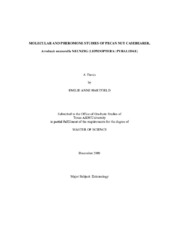| dc.description.abstract | The pecan nut casebearer, Acrobasis nuxvorella Neunzig (Lepidoptera: Pyralidae) is the most damaging insect pest of pecan, Carya illinoinensis (Wang) K. Koch (Fagales: Juglandaceae). Two sex pheromones have been identified for this species and are currently being used to assist pecan growers in the timing of insecticide applications. The discovery that there are two pheromone types produced by A. nuxvorella has led to complications in the implementation of pheromone monitoring programs. One pheromone (referred to as standard) is attractive to moths in the southern US, but not in Mexico. The other pheromone (referred to as Mexican) is attractive to moths in the southern US and in Mexico. Because most male lepidopterans respond only to a specific pheromone, it was suspected that there were two pheromone strains of A. nuxvorella, one exclusively present in the northern distribution of A. nuxvorella (US strain) and the other widely distributed from Sonora, Chihuahua, and Durango in Northern Mexico to Texas, Georgia, and Oklahoma in the US (Mexican strain).
In order to confirm the existence of the two alleged pheromone strains, AFLP markers were obtained and analyzed, male response to pheromones was observed and phenological differences were assessed. Additionally, the relative abundance of each of the two pherotypes was evaluated and the population structure of this pest across its geographic distribution was determined.
Results of genetic analysis show that the genetic differentiation between these insects is not explained by pheromone type. This information is further supported by a pheromone assay in which a large proportion of US collected A. nuxvorella males and Mexican collected A. nuxvorella males chose both pheromones when tested multiple times. Furthermore, no phenological differences were detected between the two pherotypes in the US, although significantly more male A. nuxvorella in the US are attracted to field-deployed pheromone traps baited with the standard pheromone than the Mexican pheromone. Finally, population genetic analyses indicate a high degree of genetic structure in A. nuxvorella across its geographic distribution, with the genetically distinct populations occurring in areas where A. nuxvorella is not native, but has been introduced. | en |


